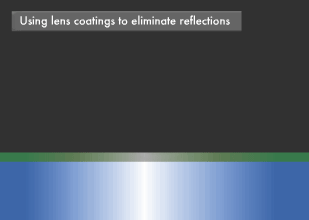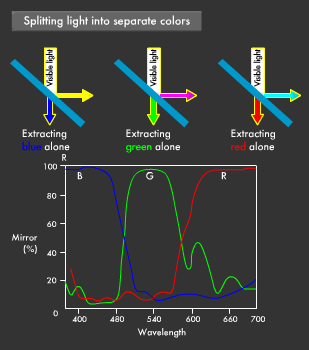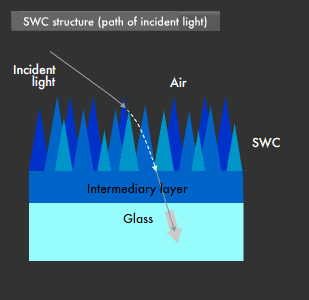How To Tell If A Large Format Camera Lens Has Faded Coatings
Canon Science Lab
Lens Coatings
The surfaces of optical lenses are covered in thin films called coatings, which play an important role in enhancing the performance of lenses.
Ordinary glass lenses transmit almost of the light that hits them, but all the same, about 4% of this calorie-free is lost to surface reflection. Since lenses have front and rear surfaces, this means that the overall loss of light from passing through one lens element is 8%. Most photographic camera lenses are made up of five to 10 elements, and then in the cease, the total amount of lite getting through the lens is reduced past nigh 50%. Lens coatings were developed to prevent surface reflection and heave lite transmission. Coating lenses enables more light to laissez passer through them.
Light is Reflected from the Surface of a Lens
Surface reflection reduces the amount of light transmitted through a lens, but this is not the only adverse outcome. Reflection inside the lens as well causes such problems as image duplication, and the manual of non-epitome low-cal to the epitome: phenomena known as ghosts and flares, respectively. Ghosts are created when light reflected from the rear surface of a lens is reflected in one case again from the front end surface, resulting in a faint second image slightly displaced from the main paradigm. Flares appear when light from the back of the lens barrel is reflected from the lens surface onto the image. Ghosts and flares caused by surface reflection reduce the quality of the image produced.

How Do Coatings Heave Light Transmittance?
Surface reflection can be reduced by applying coatings to the lens surface. You might recall that coating the lens surface would cake light, but in fact it increases low-cal transmission. This is because low-cal is reflected first by the coating surface, and then by the lens surface itself. The calorie-free reflected by the coating surface and that reflected by the lens surface take a stage difference of twice the coating thickness.

If the thickness of the coating is one quarter of the wavelength of the light to be suppressed, light of that wavelength reflected by the coating surface and low-cal reflected by the lens surface will cancel each other out. This reduces the overall amount of light reflected. In short, coatings make utilize of calorie-free moving ridge interference phenomena to eliminate reflections.
Boosting Light Transmission to 99.9% with Multilayer Coatings
Magnesium fluoride (MgF2) or silicon monoxide (SiO) are used every bit coating materials, with very thin coatings being applied evenly over the surface through such techniques every bit vacuum degradation or plasma sputtering. Still, low-cal is made upwards of many different wavelengths, and one coating cannot possibly cut out all reflected light. To cut down reflections of light of various wavelengths requires many layers of coatings. Such multilayer coatings are practical to high-end lenses. The engineering science for applying coatings of over 10 layers has been adult, and Canon'southward high-stop lenses featuring such coatings provide light transmission of 99.9% over a range that extends from ultraviolet to near-infrared light.

Coating Engineering science for Filtering Light
Lens coatings are used not but to boost light manual, but besides to filter calorie-free. Lenses coated to reverberate ultraviolet light are usually used in eyeglasses and sunglasses. It is too possible to create coatings that permit light of only a specific wavelength to pass through, and reflect all other wavelengths. In video cameras, calorie-free is first split into RGB elements (red, green and blue) before being converted into electrical signals to form an image. This splitting of low-cal is accomplished by lens coatings that permit only light of the required red, green and blueish wavelengths through.

Coating Technology Created Through Nanotechnology
The latest technologies are also beingness used in lens coating.
SWC (Subwavelength Structure Blanket), developed by Canon, is a new type of technology that uses aluminum oxide (AltwoO3) as the structural cloth of the coating in club to align endless wedge-shaped nanostructures simply 220 nm high, which is smaller than the wavelength of visible light, on a lens surface. This nano-scale coating provides a smooth transition between the refractive indexes of glass and air, successfully eliminating the boundary between substantially different refractive indexes. Reflected light can be limited to around 0.05%.

Furthermore, it has displayed first-class reflection-prevention backdrop non seen in conventional blanket even for calorie-free with a peculiarly large angle of incidence. Currently, SWC is being used in a broad range of lenses, not only wide bending lenses, which have a large curvature factor, simply as well large-diameter super telephoto lenses, greatly reducing the occurrence of flare and ghosting acquired past reflected light nearly the peripheral area, which had been difficult in the past.
Source: https://global.canon/en/technology/s_labo/light/003/03.html
Posted by: humphreyhunty1956.blogspot.com

0 Response to "How To Tell If A Large Format Camera Lens Has Faded Coatings"
Post a Comment